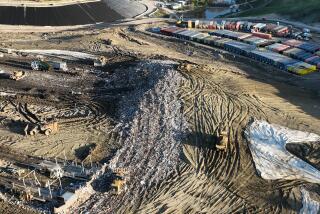Energy Dept. faces major hurdles to reopen New Mexico nuclear dump
The Energy Department has identified 7,000 steps needed to reopen its badly damaged nuclear waste dump in New Mexico, but cannot say how long it will take or how much it will cost.
The agency was expected to release a written recovery plan Thursday, but instead provided a few details about the plan, which awaits formal approval by the department.
------------
FOR THE RECORD
Sept. 22, 12:57 p.m.: An earlier version of this post misidentified Don Hancock as the nuclear waste program director at the Southwest Research Institute. He is the nuclear program director at the Southwest Research and Information Center.
------------
Outside experts say that the dump will probably not reopen until well after the start of 2016 and that the cost of the accident will approach $1 billion.
Although they didn’t talk about the cost, Energy Department officials reiterated at a briefing in Carlsbad, N.M., on Thursday that there was “strong support” in Congress for putting up the unspecified amount of money required to restart the plant. A Senate aide declined a request by the Los Angeles Times earlier this month for details about the cost negotiations.
The dump experienced two accidents earlier this year. First, a large fire broke out on a mining truck inside the mine, 2,150 feet below the surface. Shortly thereafter, a waste drum ruptured, releasing radioactivity that contaminated a significant part of the mine. Some material traveled up ventilation shafts to the surface, where 21 workers were exposed, according to an accident investigation.
The investigation so far has not explained why the drum ruptured, nor what chemicals were inside. The drum was packaged at the Los Alamos National Laboratory in New Mexico.
The mine has been shut since early February, causing a backup of nuclear waste at Energy Department weapons labs and cleanup sites across the nation.
Officials from the Energy Department and its contractors did not say when they expected the dump to reopen or how much it would cost.
Jim Blankenhorn, a manager for Nuclear Waste Partners, the operator of the dump, said the new safety document for operating the plant would take nine months to prepare. The company is led by San Francisco-based URS.
In addition, the Energy Department must drill a new ventilation shaft, repair a broken waste hoist, clean up debris and soot, stabilize the mine walls that have gone unattended for nine months, put new batteries in vehicles, install a new ventilation system, erect a bulkhead to seal off the room with the ruptured drum and seal surfaces that are contamined with radioactive dust, Blankenhorn said.
Once recovery operations begin underground, the existing damaged ventilation system will allow only two diesel-powered vehicles to operate at the same time in the mine. That will limit how fast work can proceed.
The sealing plan involves spraying the surfaces with water so that the salt melts and encapsulates the waste. Then the surface must be covered with two layers of material and, atop that, another layer of clean salt.
Don Hancock, nuclear waste program director at the Southwest Research and Information Center, a watchdog group, said the system of isolating the waste by spraying water on the salt is unproven.
Hancock said the Energy Department has repeatedly told state regulators that the dump would not reopen before early 2016, but he said that estimate is highly optimistic because so much remains unknown about the recovery.
Even if the dump reopens by then, the two-year shutdown would have consumed two years’ worth of the annual budget for the operation, amounting to about $400 million, and at least another $300 million of additional appropriations that have been discussed for repairs.
But that is unlikely to cover the full cost of the repairs, Hancock said. In addition, tons of waste are backing up across the nation, forcing laboratories and other cleanup sites to store radioactive material longer, at an unspecified cost.
More to Read
Sign up for Essential California
The most important California stories and recommendations in your inbox every morning.
You may occasionally receive promotional content from the Los Angeles Times.











